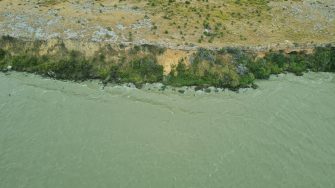
Date: Tuesday, November 9, 2021
Project: Eastern Australian Waterbird Survey
Observers: Richard Kingsford & John Porter
Pilot: James Barkell
Our morning started slowly. Regulations for our ‘essential worker’ status in South Australia required us to be tested before we entered, which we all did in Sydney, and when we came into South Australia. So it was off to Victor Harbour, where the clinic opened at 9. It was slow. We eventually got going at about 10. Not our usual early start. Thankfully the conditions were great with not much wind or heat.
We set off down past the Murray Mouth and on to do the eastern side of the North Coorong and then the South Coorong, all 120 km in total.
Starting our survey just south of the town of Goolwa.
Murray Mouth with its dredge.
There were surprisingly few waterbirds on the Coorong. The numbers of migratory wading birds were particularly low. Only Australian shelduck were in reasonable numbers, among reasonable numbers of terns, pelicans and cormorants. There were few avocets and a handful of banded stilts.
Magnificent conditions for surveying the North Coorong.
There was clearly a lot more water in the Coorong than last year. Many of the islands that were starting to appear last year were submerged.
The islands between North Coorong and South Coorong.
Once we headed down into the South Coorong, it was also great to see the pelican colony, which is nearly always going on one of the islands, and had many more breeding than last year.
Pelican colony on the South Coorong.
And there were also two small colonies of terns and a very small colony of silver gulls.
Right down the most southerly end of the South Coorong, the water was very shallow and salty and there were a few small flocks of migratory shorebirds
Most southerly point of the South Coorong.
After about three hours, we needed a break and a stretch and so landed at the small airstrip on the side of the Coorong. It was great to see some of the flowers out, vivid splashes in this grey and brown environment.
Rounded noon flower, a native specialist of these areas.
Ice plant – delicate but an introduced weed from South Africa.
Along the barrages, which separate the Coorong from Lake Alexandrina, there were hundreds of cormorants catching fish where the fresh water flowed into the brackish water of the Coorong. There was also the odd seal.
We were back for lunch and to refuel the plane by early afternoon. And then we set off to do the second count on the two lakes, Lake Albert and Lake Alexandrina.
Reedbeds of Lake Alexandrina.
Some shorelines of Lake Alexandrina have cliffs.
The cloud started coming in later in the afternoon and it was increasingly windy and not that pleasant flying. Salt came from ocean blew in with the wind, coating the gopro and so most of our afternoon footage was blurred. When we landed, we also noticed the plane was covered in a thin layer of salt. It took us three hours to eventually finish at 6 p.m.
By Richard Kingsford.
